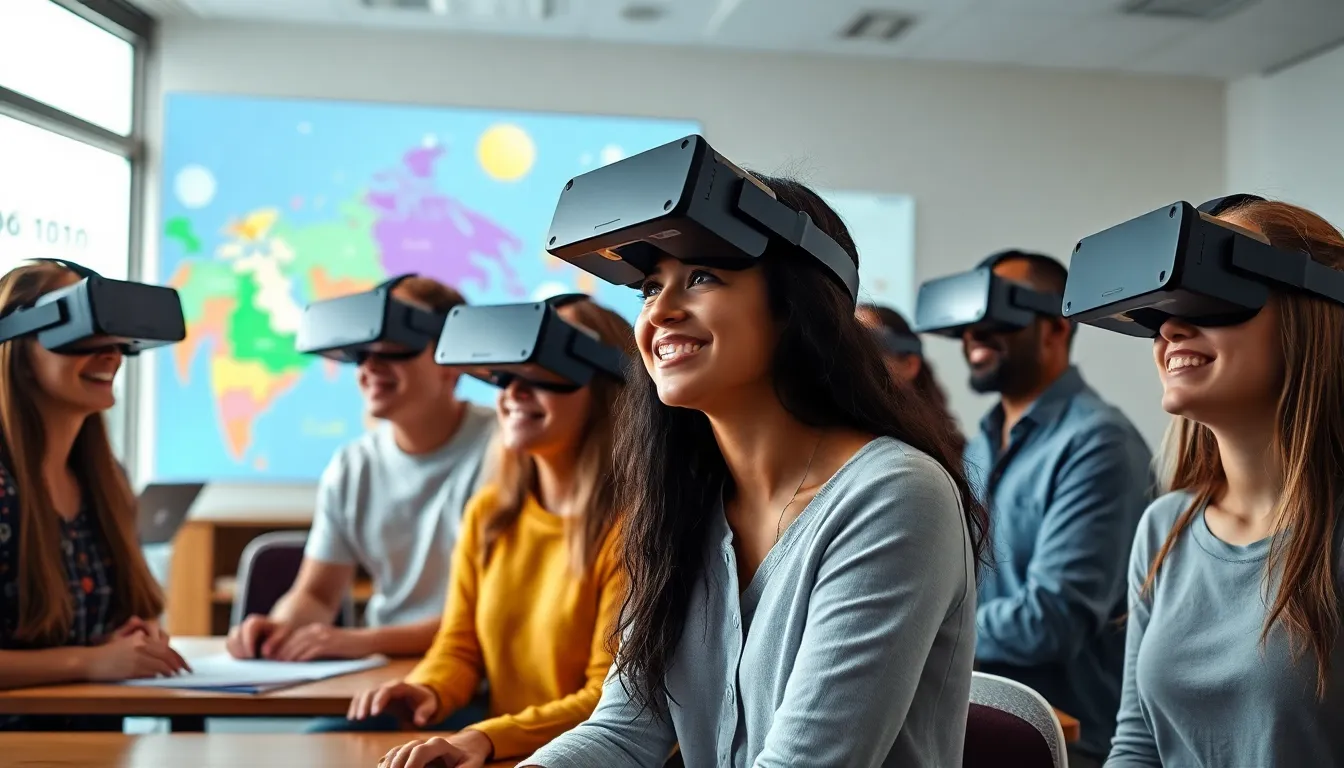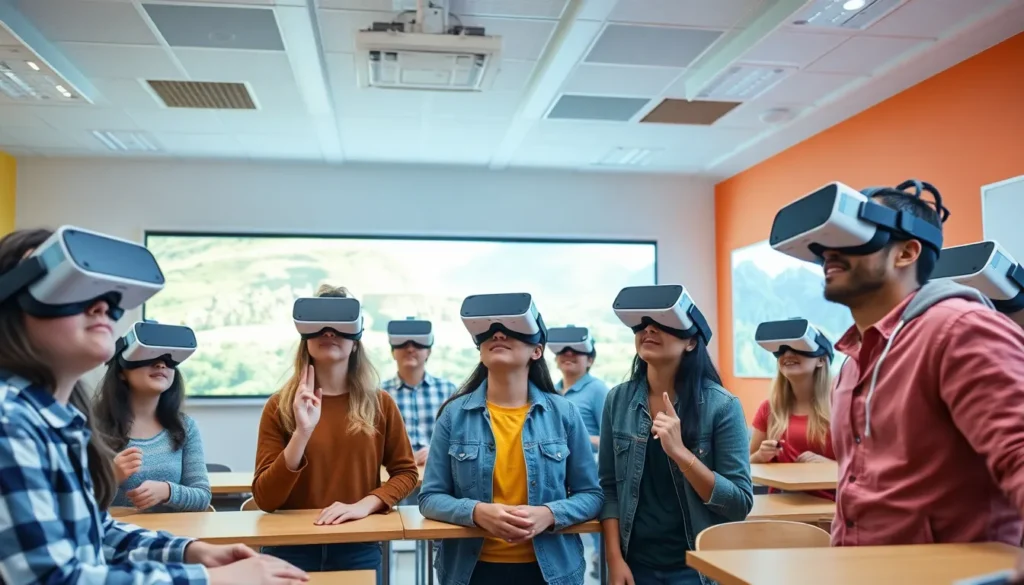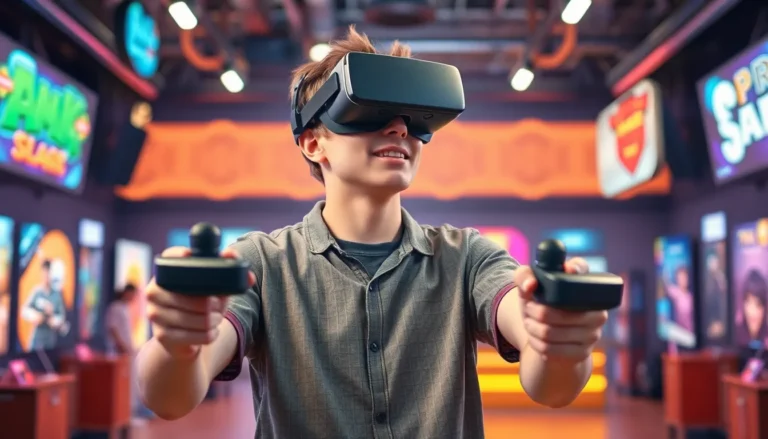Table of Contents
ToggleVirtual reality isn’t just for gamers anymore; it’s stepping into the classroom and shaking things up. Imagine students exploring ancient civilizations or diving into the human body without leaving their desks. Sounds like a sci-fi movie, right? But it’s happening now, and it’s revolutionizing education in ways that textbooks just can’t compete with.
As learning evolves, VR offers an immersive experience that makes education engaging and memorable. Forget about boring lectures and endless note-taking. With VR, students can interact with their subjects, making learning feel like an adventure. So, buckle up as we dive into the fascinating world of VR in education and discover how it’s transforming the way knowledge is delivered and absorbed.
Overview of VR and Education
Virtual reality (VR) transforms educational practices by immersing students in unique experiences. Engaging with VR technologies, learners can traverse time and space, exploring ancient civilizations or dissecting virtual anatomical models. Such engaging experiences enable deeper understanding and retention of complex subjects.
Educators increasingly integrate VR into curricula. Studies show that immersive experiences enhance motivation and foster collaboration among students. For example, VR simulations allow for group projects, where students work together in a shared virtual environment, promoting teamwork.
In addition to enhancing engagement, VR caters to diverse learning styles. Visual learners benefit from immersive graphics, while kinesthetic learners find value in interactive simulations. This adaptability makes VR a powerful tool for personalized education.
Cost remains a factor in the widespread adoption of VR in classrooms. Schools must weigh the investment against potential educational benefits. However, as technology advances, costs are expected to decrease, making VR more accessible.
Research supports the positive impact of VR on learning outcomes. A study from the University of Maryland found that students using VR performed 33% better on assessments compared to those using traditional methods. Such statistics highlight VR’s effectiveness in boosting academic performance.
Through collaborations with tech companies, educational institutions continue developing innovative VR applications. These partnerships expand access to resources, enhancing students’ educational journeys. As VR technology evolves, its potential to reshape education grows, paving the way for immersive and interactive learning experiences.
Benefits of VR in Educational Settings

Virtual reality offers notable advantages in education, significantly enhancing student experiences. This technology transforms traditional learning environments into immersive experiences.
Enhanced Engagement and Motivation
Students often find VR engaging due to its interactive nature. Virtual environments captivate their attention, making lessons more enjoyable. This engagement leads to higher motivation levels, encouraging learners to explore subjects deeply. Collaborative activities in VR foster teamwork, allowing students to work together on projects in an innovative setting. Classroom dynamics shift as students become active participants rather than passive observers.
Improved Retention of Information
Retention of information improves substantially with VR. Research from the University of Maryland indicates students using VR scored 33% higher on assessments than traditional learners. Immersive experiences provide context, helping students connect concepts to real-world applications. This connection fosters long-term memory retention. Active participation in simulations enhances comprehension, allowing students to grasp complex information more easily. Overall, VR creates more impactful learning experiences, leading to lasting educational benefits.
Challenges in Implementing VR in Education
Implementing VR in education presents several challenges that must be addressed for successful integration.
High Costs and Accessibility Issues
High costs inhibit widespread VR adoption in educational settings. Initial investments in hardware, software, and infrastructure can strain school budgets. Many institutions, especially those in underfunded areas, face difficulties obtaining the latest technology. Limited access to VR headsets and compatible devices creates disparities between schools. Although advancements in technology are reducing prices, affordability remains a significant obstacle. Educational organizations may struggle to justify expenses, even when research highlights VR’s effectiveness. Consequently, disparities in access to engaging learning experiences persist.
Technical Limitations and Training Needs
Technical limitations hinder the seamless incorporation of VR into classrooms. Device compatibility issues often arise, impacting usability across different systems. Insufficient internet bandwidth can result in lagging experiences, detracting from immersion. Adequate training for teachers is essential, yet many educators lack familiarity with VR technology and its educational applications. Ongoing professional development opportunities can bridge knowledge gaps. Innovative training programs will empower educators to leverage VR effectively, enhancing instruction. Overcoming these technical challenges remains crucial for unlocking the full potential of VR in education.
Case Studies of VR in Education
Virtual reality (VR) showcases its potential in various educational contexts. Two prominent applications highlight its effectiveness in enhancing student learning experiences.
Virtual Field Trips
Virtual field trips allow students to explore diverse locations without leaving the classroom. Students can visit historical landmarks, national parks, and even outer space. This immersive experience fosters engagement and curiosity, letting learners absorb information in a memorable way. Research indicates that students involved in virtual field trips display a 62% increase in retention compared to traditional lecture-based methods. Schools like the University of New Mexico utilize VR for remote field trips, enhancing accessibility for all students. Virtual field trips eliminate travel restrictions, ensuring students experience cultures and environments firsthand.
Interactive Science Experiments
Interactive science experiments made possible through VR offer students hands-on learning. Students can conduct chemical reactions, explore molecular structures, and simulate physics experiments in a safe virtual setting. This method cultivates a deep understanding of complex subjects, as students visualize concepts that might otherwise remain abstract. Studies show that learners engaged in VR-based science experiments score 50% higher on assessments than those using conventional methods. Schools like the University of Maryland have integrated VR into their science programs, providing students with innovative ways to explore scientific principles. Interactive experiments in VR create environments where students can test hypotheses and learn through trial and error.
Future Trends in VR and Education
Advancements in VR technology continue to shape the educational landscape. Schools increasingly adopt VR tools to create immersive learning environments, providing students with unique experiences that drive engagement. Integration of VR into various subjects enhances understanding of complex topics, like human anatomy or historical events.
Innovations in hardware and software are making VR more accessible to educational institutions. Enhanced devices with improved affordability contribute to a broader implementation of VR in classrooms, regardless of budget constraints. More educators receive training in VR applications, increasing teacher confidence in using these tools effectively.
Collaborative VR applications are emerging as a favorite among educators. Students benefit from working together in virtual settings, enhancing teamwork and communication skills. These experiences enrich classroom dynamics, making learning interactive and socially engaging.
Data from recent studies shows significant learning improvements through VR. In a controlled trial, students using VR exhibited a 62% increase in retention compared to traditional instruction methods. Such statistics highlight the potential of VR to create lasting educational impacts.
Remote learning scenarios also stand to gain from VR. Virtual reality can transport students to real-world locations or simulations, enabling them to experience content beyond the physical classroom. This adaptability allows for flexible learning environments that cater to a variety of educational needs.
Finally, industries are exploring partnerships with educational institutions to further VR development. Collaborations between tech companies and schools aim to create content that meets diverse curricular demands. By investing in partnerships, educational stakeholders can ensure VR tools evolve effectively to meet future learning requirements.
Virtual reality is poised to redefine education by offering immersive experiences that engage students in unprecedented ways. As schools continue to integrate VR into their curricula the potential for enhanced learning outcomes becomes increasingly apparent. By fostering collaboration and catering to various learning styles VR not only enriches the educational experience but also helps students retain information more effectively.
While challenges remain in terms of accessibility and costs ongoing advancements in technology promise to make VR more attainable for educational institutions. The future of learning is evolving and with it the possibilities for student engagement and understanding. Embracing VR in education could lead to a transformative shift that prepares students for a dynamic and interconnected world.




